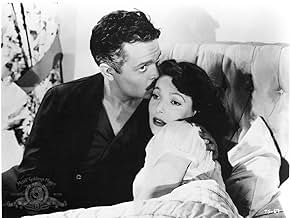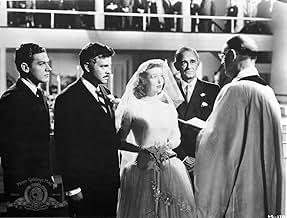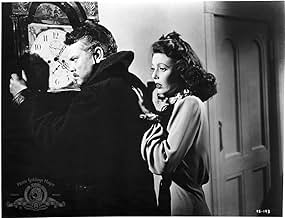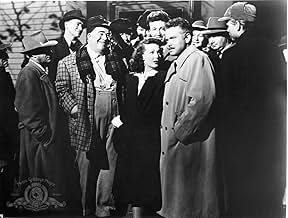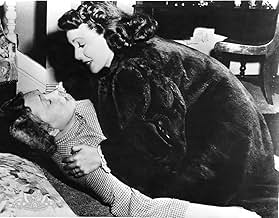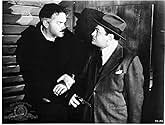IMDb-BEWERTUNG
7,3/10
29.976
IHRE BEWERTUNG
Ein Ermittler der War Crimes Commission reist nach Connecticut, um einen berüchtigten Nazi zu finden.Ein Ermittler der War Crimes Commission reist nach Connecticut, um einen berüchtigten Nazi zu finden.Ein Ermittler der War Crimes Commission reist nach Connecticut, um einen berüchtigten Nazi zu finden.
- Für 1 Oscar nominiert
- 2 Nominierungen insgesamt
David Bond
- Student
- (Nicht genannt)
John Brown
- Passport Photographer
- (Nicht genannt)
Nancy Evans
- Undetermined Role
- (Nicht genannt)
Adolph Faylauer
- War Crimes Commision Member
- (Nicht genannt)
Fred Godoy
- Undetermined Role
- (Nicht genannt)
Theodore Gottlieb
- Fairbright
- (Nicht genannt)
Joseph Granby
- Undetermined Role
- (Nicht genannt)
Ethan Laidlaw
- Todd
- (Nicht genannt)
Empfohlene Bewertungen
I picked up this movie, mostly because of the cover and the price ($4). I was happily surprised as to the quality of the movie.
The story takes place after the end of World War II. Edward G. Robinson plays a government official named Mr. Wilson. He is in charge of the Allied War Crime commission. He is looking for an elusive war criminal. His name is Franz Kindler (Orson Welles). He is suppose to be the one who came up with the Nazi plan of mass annihilation. There is no evidence, nor any photographs of Kindler. To find Franz, Wilson releases Kindler's assistant (Konrad). Konrad inadvertently leads Wilson to Harper, Connecticut. Kindler is hiding out at an all boys school as a professor named Charles Rankin. Konrad arrives on Charles' wedding day. He is getting married to the daughter of a liberal Supreme Court justice.
This movie is definitely film noir, in the lighting and the grittiness of the events. It is also quite evident that this movie was directed by Welles himself. If you have seen any one of his movies, you can see how he functions. The story is enjoyable, if not slightly predictable (especially if you have seen other film noir films or have listened to any golden age radio programs). Overall, it is nice to see Edward G. Robinson playing the good guy for a change. I also thought Billy House had a standout performance as Mr. Potter (the owner of the local general store). He provides most of the comedy relief. I highly recommend this movie for fans of Edward G. Robinson, Welles or the film noir genre.
-Celluloid Rehab
The story takes place after the end of World War II. Edward G. Robinson plays a government official named Mr. Wilson. He is in charge of the Allied War Crime commission. He is looking for an elusive war criminal. His name is Franz Kindler (Orson Welles). He is suppose to be the one who came up with the Nazi plan of mass annihilation. There is no evidence, nor any photographs of Kindler. To find Franz, Wilson releases Kindler's assistant (Konrad). Konrad inadvertently leads Wilson to Harper, Connecticut. Kindler is hiding out at an all boys school as a professor named Charles Rankin. Konrad arrives on Charles' wedding day. He is getting married to the daughter of a liberal Supreme Court justice.
This movie is definitely film noir, in the lighting and the grittiness of the events. It is also quite evident that this movie was directed by Welles himself. If you have seen any one of his movies, you can see how he functions. The story is enjoyable, if not slightly predictable (especially if you have seen other film noir films or have listened to any golden age radio programs). Overall, it is nice to see Edward G. Robinson playing the good guy for a change. I also thought Billy House had a standout performance as Mr. Potter (the owner of the local general store). He provides most of the comedy relief. I highly recommend this movie for fans of Edward G. Robinson, Welles or the film noir genre.
-Celluloid Rehab
The reason people talk about "The Stranger" 60 years later is because it was Orson Welles' first directorial effort after he was evicted from the Mercury Theater cocoon which gave us "Citizen Kane" as well as its worthy follow-ups "The Magnificent Ambersons" and "It's All True." The reason "The Stranger" is worth talking about is because it features one of the greatest performances by that criminally-ignored actor, Edward G. Robinson.
Robinson plays Mr. Wilson, an anti-Nazi hot on the trail of a war-crimes-tribunal escapee Wilson hopes will lead him to Franz Kindler, architect of the Final Solution. Kindler, we quickly discover, has set himself up as a history teacher, Mr. Rankin, at a Connecticut prep school. There he is about to marry Mary Longstreet, the daughter of a U.S. Supreme Court justice, "a liberal," Kindler relates with chilling amusement.
As Kindler, Welles gives a weak performance. There's a scene where he chews on more than his dinner as he gives himself away, by saying Marx was not a German because he was a Jew. Actually, I'd say the jig was up when he revealed his novel notions of reconstruction. The scenes between him and Loretta Young, who plays his too-trusting bride, are uncomfortably clichéd.
But Robinson is a marvel throughout the film. Of course, he is best remembered for playing a gangster, but he shone playing good guys, too. "Double Indemnity" is the best of them, though "Confessions Of A Nazi Spy" is good, too, and somewhat to the point here as it features Robinson playing a role similar to "The Stranger," though at the beginning of World War II rather than the end.
Robinson's character here, Mr. Wilson, might in fact be "the stranger" of the title, though it seems to refer to Kindler. Frankly, Kindler may be a Nazi bent on killing innocents, but Wilson is about as coldblooded a character. From the beginning, he seems to be half-playing a game with the Nazi he is chasing, smoking his pipe and staring directly into the eyes of his fearful prey. Perhaps the war crimes he has immersed himself in investigating have stripped him of any human kindness. The way he works on Mary's brother Noah and his father the judge is remarkable for Wilson's lack of humane concern, perhaps necessary, but still bone-chilling. He's like that all the way to the end. Just think for a moment about that final line he says to Mary, after all she's just been through. He's on the side of the angels, but Robinson turns in one of his most devilish performances.
There are nice scenes in and around the town of Harper, and I agree with those viewers who see shades of "Shadow Of A Doubt" in its depiction of small-town life, even though that took place in California and this is happening in Connecticut. Billy House as Mr. Potter dominates the scenes he is in with his amiable whimsy and the eyeshade he dons when he's in the middle of a serious checkers game (quarter stakes).
But "The Stranger" never really gels as a movie. Welles as director is strangely ill at ease with Wells as star. Too many cow-eyed portentous stares, not enough subtle moments like that low-key moment with Mr. Potter when he pays for a soda after finding out Mr. Wilson's hot on his trail. Young may have been a fine actress, but she doesn't get much help from a script that serves up every frail female stereotype in the book. Her every reaction seems more suited to soap opera.
Yet there's more to like here than dislike. Take the satisfying conclusion, where Kindler/Rankin has his moment of truth in the church tower where he has been working on the clock. It's the one effective scene between him and Mary, and very gripping. Welles was a gifted artist, but a superb craftsman, too, and if "The Stranger" offers more evidence of the latter, who are we to quibble? Pleasant dreams
Robinson plays Mr. Wilson, an anti-Nazi hot on the trail of a war-crimes-tribunal escapee Wilson hopes will lead him to Franz Kindler, architect of the Final Solution. Kindler, we quickly discover, has set himself up as a history teacher, Mr. Rankin, at a Connecticut prep school. There he is about to marry Mary Longstreet, the daughter of a U.S. Supreme Court justice, "a liberal," Kindler relates with chilling amusement.
As Kindler, Welles gives a weak performance. There's a scene where he chews on more than his dinner as he gives himself away, by saying Marx was not a German because he was a Jew. Actually, I'd say the jig was up when he revealed his novel notions of reconstruction. The scenes between him and Loretta Young, who plays his too-trusting bride, are uncomfortably clichéd.
But Robinson is a marvel throughout the film. Of course, he is best remembered for playing a gangster, but he shone playing good guys, too. "Double Indemnity" is the best of them, though "Confessions Of A Nazi Spy" is good, too, and somewhat to the point here as it features Robinson playing a role similar to "The Stranger," though at the beginning of World War II rather than the end.
Robinson's character here, Mr. Wilson, might in fact be "the stranger" of the title, though it seems to refer to Kindler. Frankly, Kindler may be a Nazi bent on killing innocents, but Wilson is about as coldblooded a character. From the beginning, he seems to be half-playing a game with the Nazi he is chasing, smoking his pipe and staring directly into the eyes of his fearful prey. Perhaps the war crimes he has immersed himself in investigating have stripped him of any human kindness. The way he works on Mary's brother Noah and his father the judge is remarkable for Wilson's lack of humane concern, perhaps necessary, but still bone-chilling. He's like that all the way to the end. Just think for a moment about that final line he says to Mary, after all she's just been through. He's on the side of the angels, but Robinson turns in one of his most devilish performances.
There are nice scenes in and around the town of Harper, and I agree with those viewers who see shades of "Shadow Of A Doubt" in its depiction of small-town life, even though that took place in California and this is happening in Connecticut. Billy House as Mr. Potter dominates the scenes he is in with his amiable whimsy and the eyeshade he dons when he's in the middle of a serious checkers game (quarter stakes).
But "The Stranger" never really gels as a movie. Welles as director is strangely ill at ease with Wells as star. Too many cow-eyed portentous stares, not enough subtle moments like that low-key moment with Mr. Potter when he pays for a soda after finding out Mr. Wilson's hot on his trail. Young may have been a fine actress, but she doesn't get much help from a script that serves up every frail female stereotype in the book. Her every reaction seems more suited to soap opera.
Yet there's more to like here than dislike. Take the satisfying conclusion, where Kindler/Rankin has his moment of truth in the church tower where he has been working on the clock. It's the one effective scene between him and Mary, and very gripping. Welles was a gifted artist, but a superb craftsman, too, and if "The Stranger" offers more evidence of the latter, who are we to quibble? Pleasant dreams
It's quite interesting to see two acting legends like Orson Welles and Edward G. Robinson working together, and with a cast that includes those two plus Loretta Young, along with an interesting story, "The Stranger" is a pretty good thriller.
Welles and Robinson play an interesting cat-and-mouse game in the search for a former Nazi who is hiding out in a peaceful Connecticut town. It's fair to point out, as others have done, that the dialogue at times leaves a little to be desired, but Welles and Robinson have more than enough ability to carry it off anyway.
Loretta Young has a difficult role as the wife of Welles's character. The script does her no favors, either, but she gives a creditable performance as a character who is important to the story. Among the supporting cast, Billy House particularly stands out, getting surprisingly good mileage out of his role as the store-keeper.
Perhaps the most creative aspect of the movie is the effective use of the clock tower, both as a plot device and as an idea, along with the related themes of clocks and time. The tense climax makes good use of all of these elements.
Welles and Robinson were both parts of so many outstanding movies that sometimes their merely good movies can seem to suffer by comparison. As long as you don't try to compare "The Stranger" with some other film, but just watch it for itself, it's a good thriller and an entertaining movie.
Welles and Robinson play an interesting cat-and-mouse game in the search for a former Nazi who is hiding out in a peaceful Connecticut town. It's fair to point out, as others have done, that the dialogue at times leaves a little to be desired, but Welles and Robinson have more than enough ability to carry it off anyway.
Loretta Young has a difficult role as the wife of Welles's character. The script does her no favors, either, but she gives a creditable performance as a character who is important to the story. Among the supporting cast, Billy House particularly stands out, getting surprisingly good mileage out of his role as the store-keeper.
Perhaps the most creative aspect of the movie is the effective use of the clock tower, both as a plot device and as an idea, along with the related themes of clocks and time. The tense climax makes good use of all of these elements.
Welles and Robinson were both parts of so many outstanding movies that sometimes their merely good movies can seem to suffer by comparison. As long as you don't try to compare "The Stranger" with some other film, but just watch it for itself, it's a good thriller and an entertaining movie.
The IMDb trivia page says this is Orson Welles's least favorite and least personal film. Aside from "Citizen Kane" and "The Magnificent Ambersons," I think this potent film noir is his most enjoyable—certainly more so than the ugly "Lady from Shanghai" or the overbaked and convoluted "Touch of Evil."
Charles Rankin (Orson Welles) is a professor in a respectable Connecticut town about to marry the daughter of a U.S. Supreme Court justice. But his name is fake and his past is filthy. An earnest convert to Christianity (Konstantin Shayne), who once ran a Nazi concentration camp, is capable of exposing him. "Rankin" kills this little old man and buries his body in the forest. But he isn't safe because an investigator (Edward G. Robinson) from the War Crimes Commission is on his tail. Rankin needs his own wife (Loretta Young) to help him elude capture. But his fascination with the local clock tower may prove his undoing.
As a director, Welles strains a bit too hard for effect in this film—and much too hard in everything but "Kane" and "Ambersons." In those two films all of his technical effects, striking as they are, seem effortless and exactly the right choices. Here, he has imperfect moments—such as the scene where his character is frantically, and inexplicably, trying to pick up pieces of paper—but everything else is splendid, especially the climax.
As an actor he's always compelling, but I think he makes one bad choice here. He's too guilty-looking in the early scenes. It makes us wonder why no one suspects him; and it robs us of a dramatic contrast when he begins to realize he's in imminent danger.
Loretta Young is generally a dull actress. She doesn't have enough skill to make an impression in the early scenes; but once the part requires histrionics she performs her duties well enough. Certainly her character is morally dubious and therefore fascinating in itself.
The best performance by far is Edward G. Robinson's. One of the great actors of his time, this ugly man has enough talent and star quality to underplay his role to great effect.
Orson Welles fans might find this exciting, well-plotted thriller too un-Wellesian to suit them. Otherwise, this is highly recommended.
Charles Rankin (Orson Welles) is a professor in a respectable Connecticut town about to marry the daughter of a U.S. Supreme Court justice. But his name is fake and his past is filthy. An earnest convert to Christianity (Konstantin Shayne), who once ran a Nazi concentration camp, is capable of exposing him. "Rankin" kills this little old man and buries his body in the forest. But he isn't safe because an investigator (Edward G. Robinson) from the War Crimes Commission is on his tail. Rankin needs his own wife (Loretta Young) to help him elude capture. But his fascination with the local clock tower may prove his undoing.
As a director, Welles strains a bit too hard for effect in this film—and much too hard in everything but "Kane" and "Ambersons." In those two films all of his technical effects, striking as they are, seem effortless and exactly the right choices. Here, he has imperfect moments—such as the scene where his character is frantically, and inexplicably, trying to pick up pieces of paper—but everything else is splendid, especially the climax.
As an actor he's always compelling, but I think he makes one bad choice here. He's too guilty-looking in the early scenes. It makes us wonder why no one suspects him; and it robs us of a dramatic contrast when he begins to realize he's in imminent danger.
Loretta Young is generally a dull actress. She doesn't have enough skill to make an impression in the early scenes; but once the part requires histrionics she performs her duties well enough. Certainly her character is morally dubious and therefore fascinating in itself.
The best performance by far is Edward G. Robinson's. One of the great actors of his time, this ugly man has enough talent and star quality to underplay his role to great effect.
Orson Welles fans might find this exciting, well-plotted thriller too un-Wellesian to suit them. Otherwise, this is highly recommended.
Stylish noir trading on public's concern with escaped Nazis following WWII. First part is especially intriguing since we can't be sure what's happening or who Franz Kindler is. The atmosphere is typically Wellesian— shadows galore, imaginative camera set-ups, along with dramatic use of sound. Two features, however, standout for me.
Once the plot comes into focus, we know Kindler (Welles) must do away with Meinicke (Shayne), but how. The forest scene is inspired, more menacing I think than the finale. The two men are on bended knee, in apparent communion with the forces of good, except one of them is not.
Second is Welles' depiction of small town America through druggist Potter (House, in a splendid performance). Grossly over-weight, he sits all day in front of his checkerboard, hoping to entice some sucker into a game, so he can cheat them out of a quarter. Worse, he makes customers serve themselves, apparently so he won't have to move his bulk. Not exactly the neighborly small town of Shadow of a Doubt (1943), for example.
Given the movie's many arresting features, I'm not sure why its profile isn't higher among both noirs and the Welles canon. My best guess concerns a general absence of ambiguity among both characters and situations. Instead, the screenplay is a straight pursuit film of good vs. evil that makes good use of cat and mouse, and of atmosphere, but is unexceptional in storyline. So if you're looking for stylish suspense without tricky moral complications, this is a movie to catch.
Once the plot comes into focus, we know Kindler (Welles) must do away with Meinicke (Shayne), but how. The forest scene is inspired, more menacing I think than the finale. The two men are on bended knee, in apparent communion with the forces of good, except one of them is not.
Second is Welles' depiction of small town America through druggist Potter (House, in a splendid performance). Grossly over-weight, he sits all day in front of his checkerboard, hoping to entice some sucker into a game, so he can cheat them out of a quarter. Worse, he makes customers serve themselves, apparently so he won't have to move his bulk. Not exactly the neighborly small town of Shadow of a Doubt (1943), for example.
Given the movie's many arresting features, I'm not sure why its profile isn't higher among both noirs and the Welles canon. My best guess concerns a general absence of ambiguity among both characters and situations. Instead, the screenplay is a straight pursuit film of good vs. evil that makes good use of cat and mouse, and of atmosphere, but is unexceptional in storyline. So if you're looking for stylish suspense without tricky moral complications, this is a movie to catch.
Wusstest du schon
- WissenswertesThis was the first mainstream American movie to feature footage of Nazi concentration camps following World War II.
- PatzerTwo palm trees are visible in the first scene depicting the fictional Connecticut town.
- Zitate
Mr. Wilson: Well, who but a Nazi would deny that Karl Marx was a German because he was a Jew?
- Alternative VersionenAlso available in a computer-colorized version.
- VerbindungenEdited into Ninja the Mission Force: Citizen Ninja (2012)
Top-Auswahl
Melde dich zum Bewerten an und greife auf die Watchlist für personalisierte Empfehlungen zu.
Details
Box Office
- Budget
- 1.034.000 $ (geschätzt)
- Laufzeit1 Stunde 35 Minuten
- Farbe
- Seitenverhältnis
- 1.37 : 1
Zu dieser Seite beitragen
Bearbeitung vorschlagen oder fehlenden Inhalt hinzufügen




